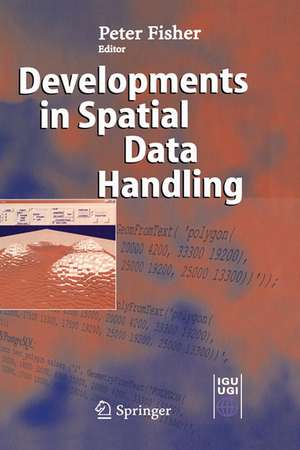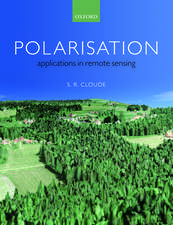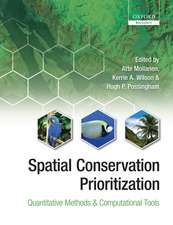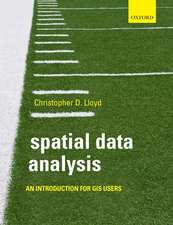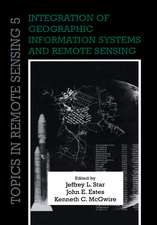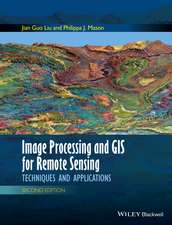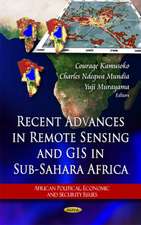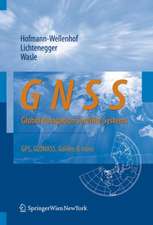Developments in Spatial Data Handling: 11th International Symposium on Spatial Data Handling
Editat de Peter F. Fisheren Limba Engleză Hardback – 5 oct 2004
| Toate formatele și edițiile | Preț | Express |
|---|---|---|
| Paperback (1) | 1235.76 lei 6-8 săpt. | |
| Springer Berlin, Heidelberg – 27 mar 2011 | 1235.76 lei 6-8 săpt. | |
| Hardback (1) | 1242.35 lei 6-8 săpt. | |
| Springer Berlin, Heidelberg – 5 oct 2004 | 1242.35 lei 6-8 săpt. |
Preț: 1242.35 lei
Preț vechi: 1515.07 lei
-18% Nou
Puncte Express: 1864
Preț estimativ în valută:
237.80€ • 258.39$ • 199.88£
237.80€ • 258.39$ • 199.88£
Carte tipărită la comandă
Livrare economică 21 aprilie-05 mai
Preluare comenzi: 021 569.72.76
Specificații
ISBN-13: 9783540226109
ISBN-10: 3540226109
Pagini: 676
Ilustrații: XIX, 676 p.
Dimensiuni: 155 x 235 x 34 mm
Greutate: 1.15 kg
Ediția:2005
Editura: Springer Berlin, Heidelberg
Colecția Springer
Locul publicării:Berlin, Heidelberg, Germany
ISBN-10: 3540226109
Pagini: 676
Ilustrații: XIX, 676 p.
Dimensiuni: 155 x 235 x 34 mm
Greutate: 1.15 kg
Ediția:2005
Editura: Springer Berlin, Heidelberg
Colecția Springer
Locul publicării:Berlin, Heidelberg, Germany
Public țintă
ResearchCuprins
Plenary of Submitted Papers.- About Invalid, Valid and Clean Polygons.- 3D Geographic Visualization: The Marine GIS.- Local Knowledge Doesn’t Grow on Trees: Community-Integrated Geographic Information Systems and Rural Community Self-Definition.- Web GIS.- A Flexible Competitive Neural Network for Eliciting User’s Preferences in Web Urban Spaces.- Combining Heterogeneous Spatial Data From Distributed Sources.- Security for GIS N-tier Architecture.- Progressive Transmission of Vector Data Based on Changes Accumulation Model.- Elevation modelling.- An Efficient Natural Neighbour Interpolation Algorithm for Geoscientific Modelling.- Evaluating Methods for Interpolating Continuous Surfaces from Irregular Data: a Case Study.- Contour Smoothing Based on Weighted Smoothing Splines.- Flooding Triangulated Terrain.- Vagueness and Interpolation.- Vague Topological Predicates for Crisp Regions through Metric Refinements.- Fuzzy Modeling of Sparse Data.- Handling Spatial Data Uncertainty Using a Fuzzy Geostatistical Approach for Modelling Methane Emissions at the Island of Java.- Temporal.- A Visualization Environment for the Space-Time-Cube.- Finding REMO — Detecting Relative Motion Patterns in Geospatial Lifelines.- Indexing.- Spatial Hoarding: A Hoarding Strategy for Location-Dependent Systems.- Distributed Ranking Methods for Geographic Information Retrieval.- Representing Topological Relationships between Complex Regions by F-Histograms.- The Po-tree: a Real-time Spatiotemporal Data Indexing Structure.- Uncertainty.- Empirical Study on Location Indeterminacy of Localities.- Registration of Remote Sensing Image with Measurement Errors and Error Propagation.- Double Vagueness: Effect of Scale on the Modelling of Fuzzy Spatial Objects.- Area, Perimeter and Shape of FuzzyGeographical Entities.- Generalisation.- Why and How Evaluating Generalised Data ?.- Road Network Generalization Based on Connection Analysis.- Continuous Generalization for Visualization on Small Mobile Devices.- Shape-Aware Line Generalisation With Weighted Effective Area.- Spatial Relationships.- Introducing a Reasoning System Based on Ternary Projective Relations.- A Discrete Model for Topological Relationships between Uncertain Spatial Objects.- Modeling Topological Properties of a Raster Region for Spatial Optimization.- Sandbox Geography — To learn from children the form of spatial concepts.- Urban Infrastructure.- Street Centreline Generation with an Approximated Area Voronoi Diagram.- Determining Optimal Critical Junctions for Real- time Traffic Monitoring for Transport GIS.- Collaborative Decision Support for Spatial Planning and Asset Management: IIUM Total Spatial Information System.- Navigation.- Automatic Generation and Application of Landmarks in Navigation Data Sets.- Towards a Classification of Route Selection Criteria for Route Planning Tools.- An Algorithm for Icon Labelling on a Real-Time Map.- Working with Elevation.- Semantically Correct 2.5D GIS Data — the Integration of a DTM and Topographic Vector Data.- Generalization of integrated terrain elevation and 2D object models.- An Image Analysis and Photogrammetric Engineering Integrated Shadow Detection Model.- Semantics and Ontologies.- Understanding Taxonomies of Ecosystems: a Case Study.- Comparing and Combining Different Expert Relations of How Land Cover Ontologies Relate.- Representing, Manipulating and Reasoning with Geographic Semantics within a Knowledge Framework.- Data Quality and Metadata.- A Framework for Conceptual Modeling of Geographic Data Quality.- Consistency AssessmentBetween Multiple Representations of Geographical Databases: a Specification-Based Approach.- Integrating structured descriptions of processes in geographical metadata.- Spatial Statistics.- Toward Comparing Maps as Spatial Processes.- Integrating computational and visual analysis for the exploration of health statistics.- Using Spatially Adaptive Filters to Map Late Stage Colorectal Cancer Incidence in Iowa.
Caracteristici
Proceedings of the International Symposium on Spatial Data Handling which is probably the premier international venue for the presentation of original research findings, and particularly strong in identifying significant new development for Geographical Information Science Includes supplementary material: sn.pub/extras
